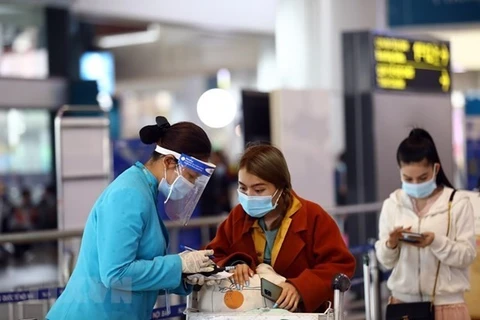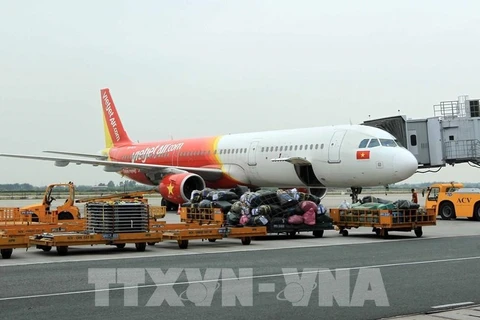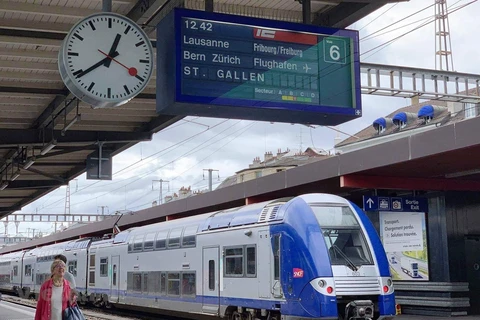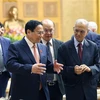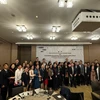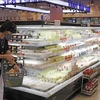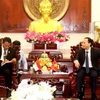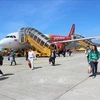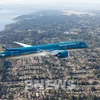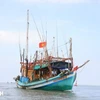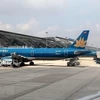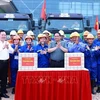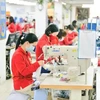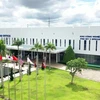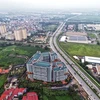 Hanoi-Hai Phong Expressway, which has been operating for six years, has spurred trans-regional socio-economic development (Photo: VietnamPlus)
Hanoi-Hai Phong Expressway, which has been operating for six years, has spurred trans-regional socio-economic development (Photo: VietnamPlus) Hanoi (VNA) – Despite important achievements in transport infrastructure development towards a synchronous and modern direction over the past years, transport systems have still been a bottleneck in the country’s path to industrialisation and modernisation, Minister of Transport Nguyen Van The has said.
Lack of investment resources
Many bright spots were seen in the overall picture of the transport sector in the 2011-2019 period, including the building of 1,041km of expressways, the upgrading of Noi Bai, Tan Son Nhat and Da Nang International Airports as well as the construction of new airports of Phu Quoc and Van Don, raising the capacity of airports across the country to over 100 million passengers per year, up 2.5 times from 2011.
Meanwhile, international gateway ports of Cai Mep-Thi Vai and Lach Huyen were invested to handle 130,000-200,000DWT vessels.
According to the minister, in the period, the transport sector focused on major projects with future visions, but it still failed to meet expectations. The target in expressway construction was below the target of 2,000km in 2020, while the railway system remained backward and the high-speed railway was not invested and only the first urban railway lines were built. At the same time, the seaport system was not optimised and the overloading situation was still seen in some airports, he added.
One of the major reasons behind the situation is the lack of investment resources which leads to the stagnancy of construction and maintenance projects, the minister explained.
He said that under the State budget plan for the 2016-2020 period, the ministry was allocated an amount that was equivalent to only 30 percent of the demand for developing new projects and maintaining the existing transport systems, while the calling for investment still faced difficulties due to high risks and problems in the legal system.
Statistics from the ministry showed that the ratio of investment in different areas of transport infrastructure in the 2011-2020 was not equal.
Specifically, investment in road transport systems accounted for 70.08 percent of the total investment in the sector, while that in railways was 11.19 percent, airports 10 percent, marine transport only 5.87 percent, internal waterways 2.02 percent and other areas 1.19 percent.
The ministry pointed out the ineffective allocation of resources as well as problems in distributing the State budget to different regions and areas, while localities have been dependent on the central budget and State-owned enterprises without building their own policies to optimise the value of transport systems.
For example, the Mekong Delta region, which has received investment equal to the average ratio of regions across the country, but due to its natural conditions with many rivers and week grounds, in reality, the investment has been below the rate of other regions, said The.
To solve the “cake dividing” problem
According to representatives of State agencies and transport experts, in order to make the transport system synchronous and modern, in the future, it is crucial to deal with problems in terms of mechanism, policy and planning, while mobilising investment resources.
Currently, the ministry has built five national planning schemes for the 2021-2030 period with a vision to 2050.
Under the planning scheme, by 2030, 80 percent of cities and provinces nationwide are expected to have an expressway running through or leading to their administrative centres, and the total length of constructed expressways is hoped to reach about 3,500-4,000 km.
Meanwhile, the transport infrastructure system is designed to ensure harmony in terms of geography, population, economic scale, regional development demand, and investment efficiency.
 Waterway transport has been strongly expanded in the Mekong Delta region, while there is no expressway connecting the system to the downtown of major cities. (Photo: VNA)
Waterway transport has been strongly expanded in the Mekong Delta region, while there is no expressway connecting the system to the downtown of major cities. (Photo: VNA) The Transport Ministry has estimated that about 1.2-2.2 quadrillion VND (52.37-96.01 billion USD) are need for transport infrastructure development in the 2021-2030 period.
In the period, the Mekong Delta region will receive about 50.69 trillion VND (2.21 billion USD), accounting for 20 percent of the total investment of the sector to develop key road expressway projects in the form of public-private partnership (PPP) and major projects in other areas.
To this end, the ministry has proposed that the Government continue to complete relevant mechanisms and policies to mobilise resources from all economic sectors, while encouraging sponsors to continue to provide ODA for transport infrastructure development, especially major projects./.
